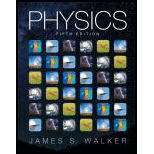
If you drop your Keys, their momentum increases as they fall. Why is the momentum of the Keys not conserved? Does this mean that the momentum of the universe increases as the keys fall? Explain.
Answer to Problem 1CQ
Explanation of Solution
The rate of change in momentum is called force. When the key is dropped, there are a number of forces act on the key. The first force is the weight of the key that act downwards and the other force is the gravitational force that is act between the two bodies that are the Earth and the key.
Since the mass of earth is very large compare to the mass of key. So, the attractive force tends to attract the key more strongly than the key to the earth and there is downward force that support the downward force which concludes the net momentum act on the key is in downward direction and increases due to acceleration of the key is increases so the momentum of the key is not conserved.
The momentum of the universe is conserved as the universe consists of planets and stars in which the planets move around the sun in a fixed orbit because of the equal and opposite force that makes them to move in a fixed orbit. The net amount of force acting by the universe on the earth is equal and opposite that makes the momentum of the universe conserved.
Conclusion
Therefore, the momentum of the key is not conserved as the forces acting on the key are not balanced and the momentum of the universe is conserved.
Want to see more full solutions like this?
Chapter 9 Solutions
Physics (5th Edition)
Additional Science Textbook Solutions
Campbell Essential Biology (7th Edition)
Campbell Biology: Concepts & Connections (9th Edition)
Human Biology: Concepts and Current Issues (8th Edition)
Chemistry & Chemical Reactivity
Chemistry: A Molecular Approach (4th Edition)
Microbiology: An Introduction
- A man holds a double-sided spherical mirror so that he is looking directly into its convex surface, 33 cm from his face. The magnification of the image of his face is +0.17. What will be the image distance when he reverses the mirror (looking into its concave surface), maintaining the same distance between the mirror and his face? Be sure to include the algebraic sign (+ or -) with your answer.arrow_forwardHow do you draw a diagram of the ruler and mass system in equilibrium identifying the anti-clockwise torque and clockwise torque? How do I calculate the anti-clockwise torque and the clockwise torque of the system with the ruler and the washers, does it come from the data in table 4? Please help, thank you!arrow_forwardExample Double pane windows have two panes of glass (n = 1.5), with a layer of air sandwiched between them. If light from outside enters the first pane at an angle of 25° from the surface normal, what angle does it enter the house at? ☑ 3 5arrow_forward
- Did your experiment results in Data Table 3 verify, to within a reasonable experimental error, the condition of equilibrium of Equation 6: Στanti-clockwise = Στclockwise? Support your response with experimental data. What does this Σ mean? My results do not show they are equal to each other, what does this mean then, and what does the data show? Thanks!arrow_forwardmicro wave.arrow_forwardmicro wave.arrow_forward
- kerjakanarrow_forwardAn object is placed 37.4cm in front of a diverging lens with a focal length of 18.1 cm. Please provide your answers in units of cm if necessary. bookmark_border1.0p3a Find the image distance. Answer Updated 6 days ago Show feedback bookmark_border1.0p3b Is the image real or virtual? Real Virtual Updated 6 days ago Show feedback bookmark_border1.0p3c Suppose the object is brought to a distance of 10.3 cm in front of the lens. Where is the image now with respect to its previous location? (Note: Ensure the sign convention you use is consistent by treating all image distances on the object side of the lens as negative.) Answer Updated 7 minutes ago Show feedback bookmark_border1.0p3d How has the height of the image changed if the object is 84.2 cm tall? Answerarrow_forwardn object is placed 37.4cm in front of a diverging lens with a focal length of 18.1 cm. Please provide your answers in units of cm if necessary. bookmark_border1.0p3a Find the image distance. Answer Updated 6 days ago Show feedback bookmark_border1.0p3b Is the image real or virtual? Real Virtual Updated 6 days ago Show feedback bookmark_border1.0p3c Suppose the object is brought to a distance of 10.3 cm in front of the lens. Where is the image now with respect to its previous location? (Note: Ensure the sign convention you use is consistent by treating all image distances on the object side of the lens as negative.) Answer Updated just now Show feedback bookmark_border1.0p3d How has the height of the image changed if the object is 84.2 cm tall? Answerarrow_forward
 Principles of Physics: A Calculus-Based TextPhysicsISBN:9781133104261Author:Raymond A. Serway, John W. JewettPublisher:Cengage Learning
Principles of Physics: A Calculus-Based TextPhysicsISBN:9781133104261Author:Raymond A. Serway, John W. JewettPublisher:Cengage Learning Physics for Scientists and Engineers: Foundations...PhysicsISBN:9781133939146Author:Katz, Debora M.Publisher:Cengage Learning
Physics for Scientists and Engineers: Foundations...PhysicsISBN:9781133939146Author:Katz, Debora M.Publisher:Cengage Learning Glencoe Physics: Principles and Problems, Student...PhysicsISBN:9780078807213Author:Paul W. ZitzewitzPublisher:Glencoe/McGraw-Hill
Glencoe Physics: Principles and Problems, Student...PhysicsISBN:9780078807213Author:Paul W. ZitzewitzPublisher:Glencoe/McGraw-Hill University Physics Volume 1PhysicsISBN:9781938168277Author:William Moebs, Samuel J. Ling, Jeff SannyPublisher:OpenStax - Rice University
University Physics Volume 1PhysicsISBN:9781938168277Author:William Moebs, Samuel J. Ling, Jeff SannyPublisher:OpenStax - Rice University Modern PhysicsPhysicsISBN:9781111794378Author:Raymond A. Serway, Clement J. Moses, Curt A. MoyerPublisher:Cengage Learning
Modern PhysicsPhysicsISBN:9781111794378Author:Raymond A. Serway, Clement J. Moses, Curt A. MoyerPublisher:Cengage Learning College PhysicsPhysicsISBN:9781938168000Author:Paul Peter Urone, Roger HinrichsPublisher:OpenStax College
College PhysicsPhysicsISBN:9781938168000Author:Paul Peter Urone, Roger HinrichsPublisher:OpenStax College





